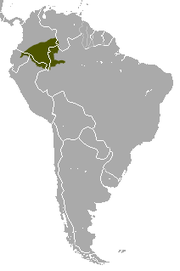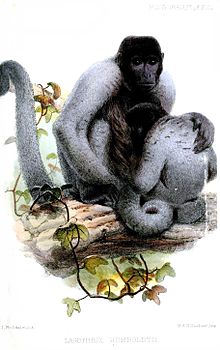| Woolly monkeys | |
|---|---|

| |
| Lagothrix lagothricha | |
| Scientific classification | |
| Domain: | Eukaryota |
| Kingdom: | Animalia |
| Phylum: | Chordata |
| Class: | Mammalia |
| Order: | Primates |
| Suborder: | Haplorhini |
| Infraorder: | Simiiformes |
| Family: | Atelidae |
| Subfamily: | Atelinae |
| Genus: | Lagothrix É. Geoffroy, 1812 |
| Type species | |
| Lagothrix humboldtii É. Geoffroy, 1812 | |
| Species | |
The woolly monkeys are the genus Lagothrix of New World monkeys, usually placed in the family Atelidae.
Both species in this genus originate from the rainforests of South America. They have prehensile tails and live in relatively large social groups.
Taxonomy
The following 2 species and 5 subspecies are currently considered to be within the genus:
| Common name | Scientific name and subspecies | Range | Size and ecology | IUCN status and estimated population |
|---|---|---|---|---|
| Yellow-tailed woolly monkey | Lagothrix flavicauda (Humboldt, 1812) |
Peru
|
Size: Habitat: Diet: |
CR
|
| Common woolly monkey | Lagothrix lagothricha (Humboldt, 1812) Five subspecies
|
Rio Tapajos in Brazil, to eastern Peru, Ecuador and Colombia, Venezuela.
|
Size: Habitat: Diet: |
VU
|
Description
Woolly monkeys are closely related to spider monkeys. They have a thick brown coat with dark gray appendages. The stomach area is black and heads are light brown. The fur color is the same for both males and females. Variation in color exist among subspecies. A prehensile tail assists in climbing and fulfills many functions of an opposable thumb. Arm and legs are about equal in length. All species are large, weighing around 7 kilograms (15 lb). Males weigh 45% more than females on average but are of equal length.
Habitat and social behaviour

Woolly monkeys are found throughout the northern countries of South America (Bolivia, Brazil, Colombia, Ecuador, Venezuela, and Peru). They usually reside in high-elevation cloud forests, seasonally flooded rainforests, and forests which are situated within Colombia's eastern plains region, although their ideal habitat is humid and mature tropical forests.
The species lives in social groups ranging from 5 to 45 individuals. Foraging groups, however, tend to consist of two to six individuals which branch out from the main group, which is probably intended to reduce food competition between individuals. Woolly monkey diets consist of fruit with an addition of leaves, seeds, flowers, and invertebrates. Each group is governed and led by an alpha male, and the social organization within a larger group is organized by age, sex, and the reproductive status of females. Reproduction in these groups is characterized by promiscuity; one male (either the alpha or subordinate) mates with more than one female, just as females mate with more than one male. Shortly after the females reach maturity, they leave their natal groups to avoid any occurrence of inbreeding, while males tend to remain in their natal groups.
Play not only serves as a bonding process to rekindle relationships among individuals, but is also a way the species establishes a hierarchy or social pecking order, as well as passive food sharing, which is also considered a common routine in the species. Woolly monkeys have an elaborate system of vocalization and olfactory, visual, and tactile communication. These can be used to coordinate group activities, indicate aggression, affection, and marking, and establish territories.
Predation and preservation
Woolly monkeys are hunted by a variety of species of eagles and cats, such as the jaguar. Their main predators, however, are humans, who hunt the species both for food and for the illegal pet trade. Habitat encroachment is also threatening the survival of the species; all these factors are believed to be the cause of the species' recent decline. Woolly monkeys are now considered highly endangered, and captive individuals are bred to ensure the survival of the species as part of the International Breeding Program for Endangered Species.
See also
References
- ^ Groves, C. P. (2005). Wilson, D. E.; Reeder, D. M. (eds.). Mammal Species of the World: A Taxonomic and Geographic Reference (3rd ed.). Baltimore: Johns Hopkins University Press. pp. 151–152. ISBN 0-801-88221-4. OCLC 62265494.
- "ITIS - Report: Lagothrix". www.itis.gov. Retrieved 2021-11-20.
- Database, Mammal Diversity (2021-11-06), Mammal Diversity Database, doi:10.5281/zenodo.5651212, retrieved 2021-11-20
- ^ Stevenson, P. R. (2006). "Activity and ranging patterns of colombian woolly monkeys in north-western amazonia". Primates. 47 (3): 239–47. doi:10.1007/s10329-005-0172-6. PMID 16505944. S2CID 10831742.
- "Primate Factsheets: Woolly monkey (Lagothrix) Taxonomy, Morphology, & Ecology". Primate Info Net. National Primate Research Center, University of Wisconsin. Retrieved 2017-08-03.
- Defler, T. (1996). "Aspects of the Ranging Pattern in a Group of Wild Woolly Monkeys (Lagothrix lagothricha)". American Journal of Primatology. 38 (4): 289–302. doi:10.1002/(sici)1098-2345(1996)38:4<289::aid-ajp1>3.0.co;2-v. PMID 31918484. S2CID 85137196.
- ^ Strier, Karen B. (1997-01-01), Slater, Peter J. B.; Rosenblatt, Jay S.; Snowdon, Charles T.; Milinski, Manfred (eds.), Behavioral Ecology and Conservation Biology of Primates and Other Animals, Advances in the Study of Behavior, vol. 26, Academic Press, pp. 101–158, doi:10.1016/S0065-3454(08)60378-2, ISBN 9780120045266, retrieved 2021-11-20
- ^ "Woolly monkey". WNPRC. Retrieved 2021-11-20.
- World Book (1st ed.). Chicago: World Book. 2020. p. 402. ISBN 0716601206.
Defler T., Stevenson P. (2014) Introduction: Studying Woolly Monkeys. In: Defler T., Stevenson P. (eds) The Woolly Monkey. Developments in Primatology: Progress and Prospects, vol 39. Springer, New York, NY. https://doi.org/10.1007/978-1-4939-0697-0_1
G. H. Theilen, D. Gould, M. Fowler, D. L. Dungworth, C-Type Virus in Tumor Tissue of a Woolly Monkey (Lagothrix spp.) With Fibrosarcoma, JNCI: Journal of the National Cancer Institute, Volume 47, Issue 4, October 1971, Pages 881–889, https://doi.org/10.1093/jnci/47.4.881
Further reading
- Thomas R. Defler & Pablo R. Stevenson (eds.): The Woolly Monkey: Behavior, Ecology, Systematics, and Captive Research. Springer, New York 2014. ISBN 978-1-4939-0696-3 (print); ISBN 978-1-4939-0697-0 (eBook)
External links
| Extant species of family Atelidae | |||||||
|---|---|---|---|---|---|---|---|
| |||||||
| Alouattinae | |||||||
| Atelinae |
| ||||||
| Category | |||||||
| Taxon identifiers | |
|---|---|
| Lagothrix | |





